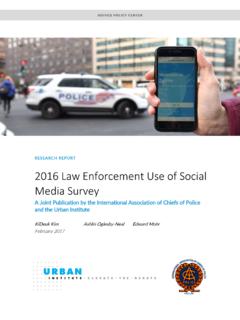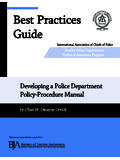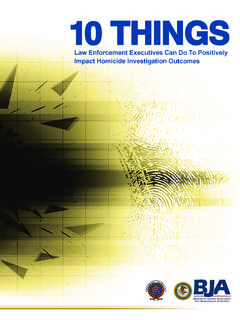Transcription of Best Practices Guide - IACP Homepage
1 SSttrraatteeggiicc PPllaannnniinngg::BBuuiillddiinngg SSttrroonngg PPoolliiccee--CCoommmmuunniittyy PPaarrttnneerrsshhiippss iinn SSmmaallll TToowwnnssbbyy CChhiieeff DDaavviidd KKuurrzzIInntteerrnnaattiioonnaall AAssssoocciiaattiioonn ooff CChhiieeffss ooff PPoolliicceeThis project supported by a grant from: SSmmaalllleerr PPoolliiccee DDeeppaarrttmmeennttss TTeecchhnniiccaall AAssssiissttaannccee PPrrooggrraammBJABB uurreeaauu ooff JJuussttiiccee AAssssiissttaanncceeOffice of Justice Programs Department of JusticeBBeesstt PPrraaccttiicceessGGuuiiddeeBest Practices Guide for Strategic Planning: building Police- community Partnerships in Small Towns By Chief David L. Kurz, Duham, New Hampshire Police Department r Motivation for the Strategic Plan When the police department in Durham, New Hampshire, wanted to develop a strategic plan there was an acknowledgement that the approach must be different from those of larger police agencies.
2 While the number of demands upon the department could legitimately justify not even exploring the topic, the department still needed to establish long-term goals and develop a strategy that would ensure success. The Durham strategic plan project is comprised of three phases, 1) a survey of citizen satisfaction with police services, 2) an internal agency survey of police officer satisfaction and, 3) a one-day planning session attended by police officers and community leaders. Due to the strategic planning process, the agency has an evolving set of goals and corresponding plans to reach them with the renewed support and cooperation of the community it serves. Benefits of the Strategic Plan 1.
3 community Perceptions and Needs. The Durham Police Department decided to treat its constituents as partners and customers. Like any business, it needed to identify it constituent s needs to know how to meet them. A community Safety Survey was designed. 2. building community Partners. community members often have questions about police services and how they re delivered. When constituents are familiar with police services, they are more likely to be supportive. The One-Day community Planning Session has built strong community -police partnerships. Officers indicate the respect and cooperation they are receiving from the community has improved greatly since the strategic planning process was lunched several years ago.
4 3. Internal Agency Improvements. Officers responses to the agency s Internal Survey informed the chief more effectively about his officer s views and needs so that he could adequately respond. Policing Durham: Though the crime rate in Durham is among the lowest in the state, the town s police department nevertheless has its hands full. With 19 sworn officers and three support staff, the CALEA accredited police department serves a fluctuating population comprised of 8,700 full-time citizens and 12,000 students of the University of New Hampshire (UNH). The unique policing environment demands a balance between supporting the desires of the permanent residents and students. In many ways, the community is dominated by the UNH school year.
5 Policing in this environment becomes extremely demanding commencing at school opening in September until Homecoming Weekend in late October. These new students are strangers to the area, have never been away from home, do not know their classmates, often make bad decisions with strangers and often abuse a variety of substances. Experimentation with alcohol dominates the social scene. In many ways, 1the officers are challenged with allowing students appropriate flexibility while responding to the concerns and demands of the permanent residents simultaneously. Durham residents have come to expect professional and personal response to their calls for service, and the department has long maintained a good relationship with the community .
6 But there was reason for concern when a citizens group told the new police chief that the residents saw the department as distant from the people it served. The chief decided that if the police department wanted to improve public perceptions of the police, it needed to improve community partnerships and work together with those partners to change their image and way of doing business. The department determined to treat its constituents as partners and customers and like any good business, find out what its customers wanted. Treating Police Constituents as Valued Customers One value of embracing a business philosophy for a police agency is that it makes the public the ultimate arbiter of what constitutes quality policing.
7 community Policing is a philosophy that calls for police and community cooperation to determine the problems and desires of the community and subsequently to develop a strategy that will address those needs. community policing also reinvigorates the community s sense of responsibility for maintaining law and order. The same is true with public safety - law enforcement is ultimately responsible for protecting the public, but good community policing empowers citizens to do their part. Citizens today often question their local government about service levels, budget limitations, and community involvement. It is no surprise then, that communities have questions for their police managers about what services their police departments provide and how they deliver them.
8 It behooves police chiefs to take the lead in providing the answers. An environment that encourages discussion and allows for community feedback is the foundation of any community policing initiative. The development of a strategic plan helped the Durham Police Department create such an environment. Initiating the Strategic Planning Process Unsure of how to launch a strategic planning initiative, the Durham Police Department began by doing some research. It found that most of the literature on the subject suggested that strategic planning was time consuming, sapped limited human resources and was just too involved for a small police agency like Durham to initiate. Nevertheless, the department felt that strategic planning would help to reveal the road the organization should take and it embraced some of the basic principles of the business world, such as soliciting and valuing client comments, monitoring performance, promoting continuous improvement and inviting worker participation.
9 The agency launched its strategic planning initiative with a community survey, certain these methods could help the police achieve high levels of customer satisfaction. Phase One: community Survey Determining community Perception. community surveys offer police a significant opportunity of finding out the answers to these questions 1) How do our customers perceive crime in the community 2) How does crime affect them? 3) How does the community perceive the police department? Several strategies that Durham Police Department has employed to ease the challenges of development, distribution and analysis of the responses are: 21. Existing Surveys. Look for existing surveys at the IACP, where a number of examples are on line at Another excellent resource is found at the Office of community Oriented Policing at the Department of Justice.
10 Durham s survey employs fifty questions to gauge customer satisfaction with the police force, concerns about crime and quality-of-life perceptions. To ensure that survey responses will allow for conclusions to be easily measured, use a rating scale of 1 to 5, yes or no, or true or false. If questions demand a diverse, write-in answer, quantifying the responses will be very difficult and time consuming. 2. Mailing Tips. To save limited funding, Durham s initial survey was distributed as an insert in the annual town report. Other possibilities may exist in your community by inquiring with other municipal departments about up-coming community -wide mailings. To encourage responses, the questionnaire is designed to be folded so that the pre-paid and self-addressed card keeps the response process simple.

















